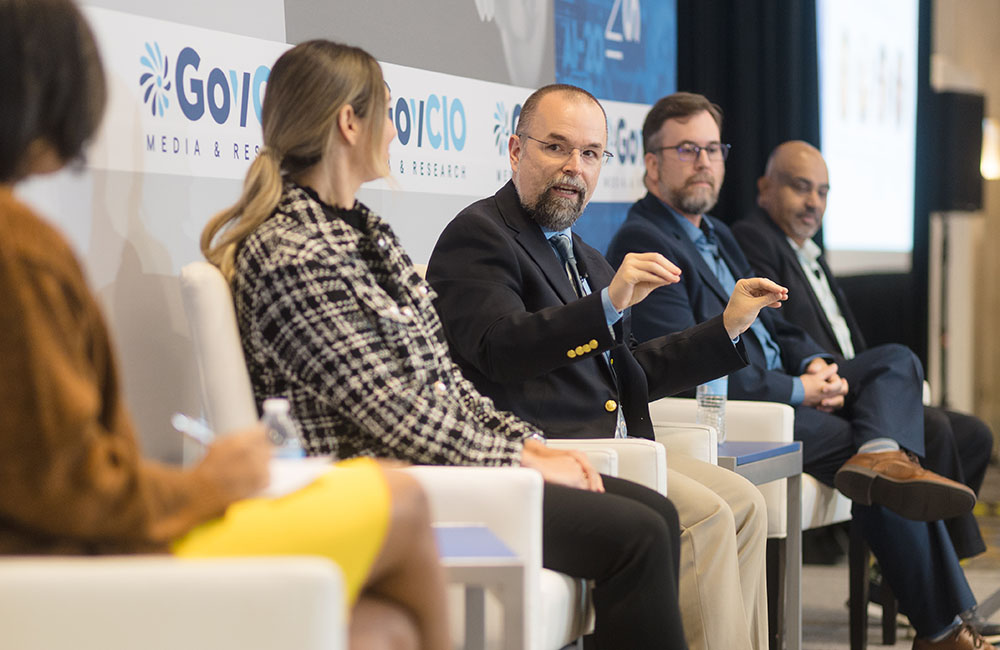VA Digital Modernization is Foundation of COVID-19 Response
The agency’s IT transformation initiative allowed VA to effectively adapt services around the demands of the pandemic.

The Department of Veterans Affairs’ preexisting IT transformation initiatives helped the agency more effectively respond to the demands of the COVID-19 pandemic, noted agency leaders at the GovernmentCIO Media & Research House Oversight and VA Digital Modernization event Wednesday.
Deputy Chief Information Officer Dominic Cussatt noted that VA began to overhaul its services in large part due to the immense scope of its responsibilities to America’s veterans and the nation as a whole.
“VA is a very large enterprise — we serve up to 20 million veterans, and have over a 400,000-person workforce,” Cussatt said. “We’re also the backup health care system in the United States and can even act as a backup to the Defense Department during times of crisis to handle patients. It’s a big mission with high stakes, and we take IT support to this mission very seriously.”
Cussatt emphasized that the goal of VA’s broader digital modernization push was ultimately practical, with an endpoint focus on improving the day-to-day experience of VA customers. This resulted in using newfound technical applications to facilitate and expand the delivery of existing VA services, resulting in a foundational tie to the agency’s essential mission.
“What we want to do is not IT for IT’s sake, but IT that is going to create a positive impact for veterans, for their lives, their care and for their families,” Cussatt said.
The agency’s considerable investment in a broad-reaching IT transformation program has paid considerable dividends during the COVID-19 pandemic, especially in allowing for continuity of services that would have otherwise been limited or interrupted altogether by the abrupt changes.
“In terms of COVID, we think this IT modernization and subsequent digital transformation set us up nicely to be able to withstand the demands of COVID-19 and how we had to move to a virtual workforce and support telehealth and telecounseling,” Cussatt said. “Because we had all these steps in place, we were able to transition quite nicely.”
In examining the agency’s rapid deployment of a COVID-19 response, VA Office of Information Technology Chief of Staff Susan Perez found that preexisting infrastructure development allowed for a particularly agile and comprehensive shift to remote work as well.
“Right away we knew to take this divide-and-conquer approach so we could leverage all the great things we’d put in motion with our strategic plans. We also had some good lessons in testing ourselves in advance … and we were able to scale very quickly so that not only our typical workforce would be okay to work in that remote posture. But we scaled so that if we had every employee that needed to go into a remote posture, we could support it,” Perez said.
Much of this continuity of services and allowance for an exponential increase in remote work was enabled by the VA’s cloud migration program, which permitted an unprecedented scope of dispersed access.
“Throughout the course of that, we moved VA to the cloud. We were one of the biggest entities in government that really pushed a move to the cloud,” Cussatt said. “We’ve moved hundreds of applications and services to the cloud. Having that instance enabled us to very quickly scale into the cloud and develop that capacity we needed.”
Ultimately, digital modernization push has its foundation in both the expansion of services, as well as building resiliency and ensuring veterans have access to care irrespective of circumstance or national crisis.
“We wanted to make sure that we weren’t just throwing money at the problem. We wanted to think about what was going to position us to weather this storm,” Cussatt said. “Ot’s not just about this pandemic response. There are natural disasters that occur, homeland security issues that secure. VA has no choice but to be up and ready 24/7. We’ve got to provide health care, we’ve got to save lives, we’ve got to take care of people’s families.”
This is a carousel with manually rotating slides. Use Next and Previous buttons to navigate or jump to a slide with the slide dots
-

NSF Wants Industry Driving Quantum Innovation
The agency is pushing for partnerships to enhance the research community as Congress weighs additional legislation.
3m read -

White House Science Chief: US-Driven AI Sets Global Standards
Michael Kratsios outlined how American AI technology on the global stage will help standardize the tech and counter China’s influence.
5m read -

Modernizing Critical Infrastructure in the Face of Global Threats
Officials are expanding the latest strategies in boosting defense infrastructure, including securing satellite communications, upgrading enterprise-wide technology, optimizing data management.
20m watch -

Trump AI Orders Call for Speed in Building Infrastructure
The directives call for expanding AI infrastructure, streamlining federal permitting and promoting AI exports.
4m read -

DOD Accelerates Software Modernization with Agile DevSecOps Push
The Pentagon's software implementation plan tackles cultural hurdles and integrates security early to deliver critical capabilities faster.
6m read -

White House Unveils AI Action Plan to Secure Global Dominance
The strategy outlines steps to accelerate private sector innovation, build critical infrastructure and advance U.S. leadership in AI policy and security.
3m read -

VA's Platform One Powers Rapid Innovation to Bolster Digital Services
VA's Platform One accelerates software development timelines from weeks to hours, ultimately enhancing digital services for veterans.
5m read -

Federal Leaders Receive Federal IT Efficiency Flywheel Awards from GovCIO Media & Research
Five federal IT leaders received Flywheel Awards for driving innovation and modernizing technology at the Federal IT Efficiency Summit.
5m read -

Doing More with Less is Muscle Memory for IRS, Former Deputy CIO Says
Darnita Trower discusses her experience, the legacy she’s left behind and how she pushed the IRS to modernize itself,
20m watch -

Opinion: Original Intelligence Is the Missing Piece for AI Transformation
Limitations of AI agents and development drive growing needs for workforce development and "original intelligence."
3m read -

VA CIO Targets Modern IT and Smarter Workforce Alignment
Agency leaders told lawmakers they are focused on trimming legacy systems and restructuring its workforce to streamline operations.
3m read -

Pentagon's $200M AI Contracts Signal Broader Effort to Transform Talent
The Army is leveraging Silicon Valley, reservist programs and new hiring strategies to integrate critical digital skills in its ranks.
5m read




